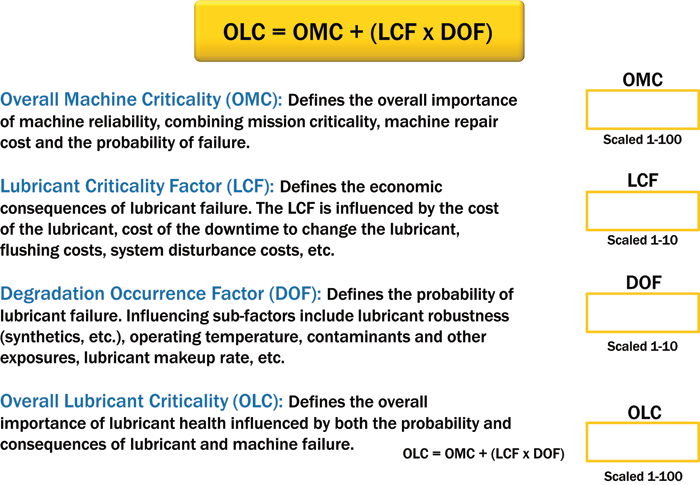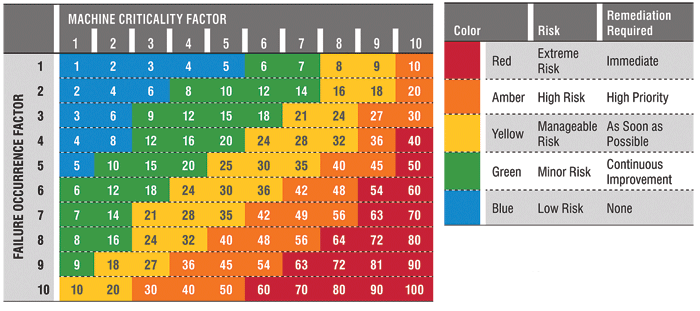Don't Forget Lubricant Criticality When Designing Oil Analysis Programs
In a previous issue of Machinery Lubrication, I discussed the concept of Overall Machine Criticality (OMC) and its importance on a wide range of decisions relating to machinery lubrication and oil analysis. These decisions, when optimized, define the Optimum Reference State (ORS) needed to achieve the desired level of machine reliability. It is intuitively obvious that smart maintenance decisions require a heightened sense of both the probability and consequences of machine failure.
However, when lubricants fail, there are consequences that are, at least initially, independent of machine failure. These include the lubricant replacement cost (material, labor, flushing, etc.) and associated downtime. These costs can exist in the presence of a perfectly healthy and operating machine. Of course, lack of timely replacement of a defective lubricant will invariably lead to dire machine failure consequences. For some machines, these cascading events can produce enormous collateral damage and financial hardship to an organization.
In the next issue of Machinery Lubrication, I will explain how nearly all decisions related to lubricant analysis and inspection depend on four factors: Overall Machine Criticality, Overall Lubricant Criticality, Machine Failure Modes Effects Analysis (M-FMEA) and Lubricant Failure Modes Effects Analysis (L-FMEA).
For instance, regarding inspections, these factors influence what to inspect, when to inspect and how to inspect. In relation to oil analysis, these factors affect where to sample, how often to sample, which tests to conduct, which alarms to set and the general data-interpretation strategy.
Machine Criticality vs. Lubricant Criticality
Figure 1 shows the relationship between machine and lubricant failure. On the left are common causes of lubricant failure and machine failure. For example, heat, aeration and contaminants are known to be highly destructive to lubricants. In a similar sense, overloading, misalignment and contamination can abruptly cause a machine to fail. Note how contamination not only can fail a lubricant but also can fail a machine directly without the need to harm the lubricant first. You could say the lubricant is complicit by transporting contaminants to sensitive and critical frictional surfaces. When a lubricant fails, there is imminent danger of machine failure, hence the downward arrow from lubricant failure to machine failure.

It is best to not only list failure causes but also rank them in terms of probability and severity. This helps allocate resources by priority. From lubricant and machine failure come specific consequences, which are listed on the right in Figure 1. Again, these consequences are mutually exclusive. Lubricant failure consequences include oil replacement costs, downtime during the oil change, labor to change the oil and flushing costs. Machine failure consequences relate to safety, spare parts, labor to repair and downtime (e.g., production losses).
There is slight comingling of these failure consequences. For instance, lubricant failure may cause complete machine failure or only partial machine failure, such as dropping the machine’s remaining useful life (RUL) from 80 to 40 percent. Conversely, when a machine (or one of its components) fails due to mechanical causes, the heat and wear debris produced can completely or partially destroy the oil.
Calculating Overall Lubricant Criticality
The Overall Lubricant Criticality (OLC) defines the importance of lubricant health and longevity as influenced by the probability of premature lubricant failure and the likely consequences (for both the lubricant and the machine). The proposed method for calculating the OLC is shown in Figure 2. Like many such methods, the approach is not an exact science but nevertheless is grounded in solid principles in applied tribology and machine reliability.

The calculation is quite simple. Overall Lubricant Criticality equals Overall Machine Criticality plus the multiplied product of the Lubricant Criticality Factor (LCF) and the Degradation Occurrence Factor (DOF). The OLC is scaled from 1 to 100. All calculated values more than 100 are reduced to the default maximum of 100.
As mentioned previously, the OMC was discussed in great detail in the March-April 2013 issue of Machinery Lubrication. It is the multiplied product of the Failure Occurrence Factor (likelihood of machine failure) and the Machine Criticality Factor (consequences of machine failure). It is shown again as a matrix in Figure 3.

Because lubricant failures are common causes of machine failures, it is no surprise that the OMC plays a significant role in calculating Overall Lubricant Criticality.
Lubricant Criticality Factor
The LCF defines the specific economic consequences of lubricant failure separate from machine failure consequences. The LCF is influenced by the cost of the lubricant, the cost of downtime to change the lubricant, flushing costs and system disturbance costs (e.g., the fishbowl effect). For instance, machines that use large volumes of expensive, premium lubricants will understandably have high LCF values. It is not unusual for main lube oil systems on turbine generators in power plants to have lubricant investments in the range of hundreds of thousands of dollars. In such cases, the cost of premature lubricant failure can be enormous, not to mention the potential impact on the machine’s reliability. Studies have shown the true cost of an oil change can far exceed 10 times the apparent cost (labor and oil costs). The LCF is subjectively scaled from 1 to 10, with 10 representing extremely high criticality.
Degradation Occurrence Factor
The DOF defines the probability of premature lubricant failure. The conditions that influence this probability are shown below. Collectively, the DOF is scaled 1 to 10.
Lubricant Robustness - Synthetics and other chemically and thermally robust lubricants lower the DOF.
Operating Temperature - Lubricants exposed to high operating temperatures, including hot spots, can experience accelerated oxidation and degradation. The presence of such conditions will raise the DOF.
Contaminants - Contaminants such as water, dirt, metal particles, glycol, fuel, refrigerants, process gases, etc., can sharply shorten lubricant service life. The presence of such exposures will raise the DOF.
Lubricant Volume and Makeup Rate - Lubricant volume relates to the amount of additives available to fight oil degradation, the estimated runtime to complete additive depletion and the density of contaminants. In normal service, it can take years to burn through the additives in systems containing thousands of gallons of lubricant. The makeup rate refers to the introduction of new additives and base oil. New additives replenish depleted additives, and new base oil dilutes pre-existing contaminants. High oil volume and a high makeup rate will reduce the DOF.
Armed with both the OMC and OLC, lubrication and reliability professionals have the foundational elements needed to better design lubrication and oil analysis condition monitoring programs. While some guesswork may be required, using this method will prevent wild guesses. In turn, extreme waste and poor reliability can be avoided.
The goal is to optimize maintenance and reliability decisions. Understandably, best practice varies considerably from machine to machine. Precision lubrication is another way of saying one size does not fit all. It’s time to get it right. In the next issue of Machinery Lubrication, this topic will be explored further in the context of oil analysis and inspection. Take the next step. Learn how Noria can help transform your lubrication program.
